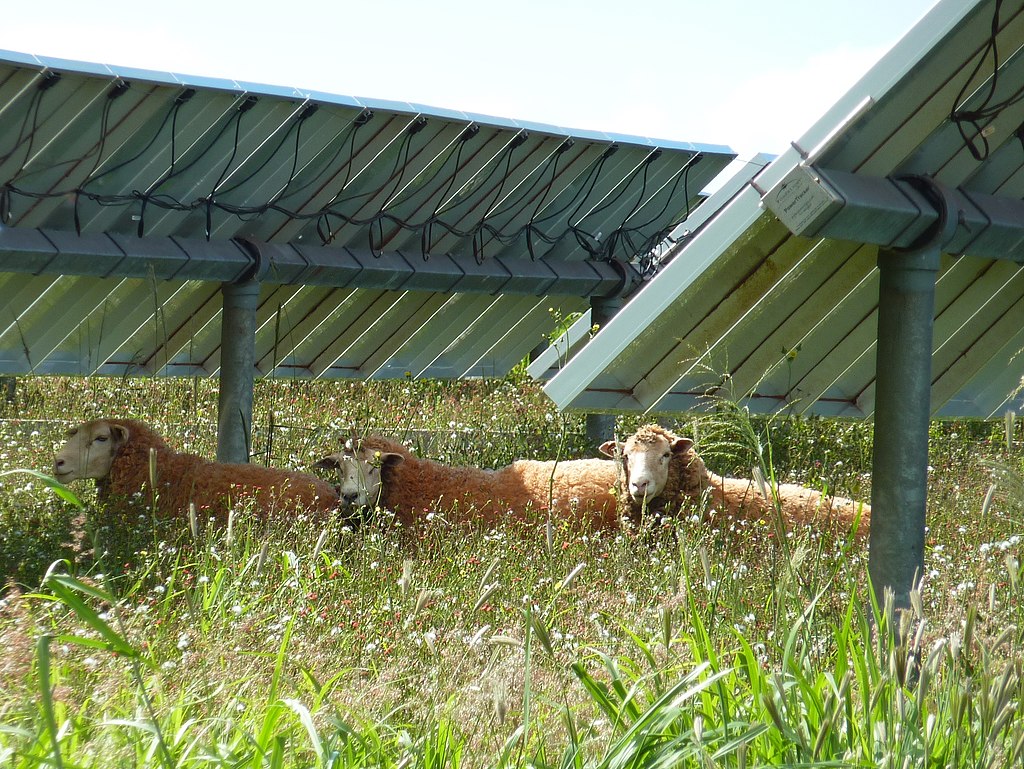How Agrivoltaics Supports Renewable Energy, Preserves Farmland, and Boosts Food Production

Sheep living at the La Ola Solar Farm on Lanai, Hawaii keep the weeds and grass trimmed in the hard-to-reach places between and under the solar panels. Photo by Merrill Smith, U.S. Department of Energy, via Wikimedia Commons.
At Seneca Environmental, we go beyond what’s standard in renewable energy projects to achieve Earth-healing benefits — we call these “+1s.” One of the ways to incorporate +1s is to site solar projects on farms, in a practice known as agrivoltaics. This dual use of land benefits crops, livestock, farmers, and their surrounding communities.
Why site solar on farms? To address climate change at the speed and scale that’s necessary, we must find more places to build solar projects. In urban areas, rooftops, parking lots, and parking structures can host a surprising amount of solar. In rural areas, farms provide further unexpected possibilities. A study by Oregon State University found that the U.S. could generate 20% of our electricity needs by siting solar projects on just 1% of our farmland.
That doesn’t mean taking farms out of commission. On the contrary — agrivoltaics can help farms stay in business, increase crop production, and regenerate soil. Agrivoltaics also benefits solar developers, communities, and our nation as a whole.
Benefits for farms
Solar panels on a farm can be sited either on parts of a farm that are not productive or alongside crops. Adding a new revenue stream on unproductive land can be a boon to farmers, and on productive land, solar panels can also benefit crops.
When solar panels are co-located with crops, they can increase production for crops that do better with intermittent shade from the panels. These include leafy greens, root crops, blueberries, tomatoes, grapes, and many more. Shading is especially beneficial in the Southwest, where crops can be damaged by getting too much sun.
Where it doesn’t make sense to install panels with crops, farmland can be preserved and enhanced by pausing crop production temporarily. That pauses the constant tilling of the soil — which destroys microorganisms in the ground and releases carbon into the atmosphere — allowing the soil to regenerate. At the end of the project’s life cycle, the farm can resume operations, with increased crop productivity.
Whether or not crop production is paused, it’s becoming much more common to co-locate panels with plants that attract pollinators. That can increase yields on farms and even on neighboring farms, benefitting the larger community, and it can improve project aesthetics.
Agrivoltaics brings farmers another welcome benefit: cost savings and increased revenues. Land lease payments for solar projects bring farmers an extra long-term revenue stream — one that, unlike crops, is guaranteed, predictable, all profit, and doesn’t require any capital outlay or extra work on the part of the farmer. It can even pay more than crops. The extra income may allow a farm to keep operating and to stay in the family.
Agrivoltaics projects can also reduce energy costs on electricity-intensive farms. The shade from the panels can reduce a farm’s water use, which is particularly welcome in regions with droughts and lowering water tables.
Benefits for solar developers
As it becomes increasingly challenging to find places to site commercial-scale and small utility-scale solar projects, solar developers are turning to farms as prime locations. In addition to having space for solar projects, farms tend to have access to the necessary electrical infrastructure for them.
With many farmers struggling in that volatile business, they are often quick to understand the benefits of solar leases. Farmers who see the benefits can make excellent partners for solar developers.
Siting projects on farms is also good for solar production. Panels installed above crops or pollinator plants stay cooler, which increases their efficiency and their lifespan.
Livestock grazing can also be incorporated in agrivoltaics projects, helping maintain vegetation around the panels while providing shade for the animals. A solar farm in Oberlin, Ohio found that using sheep to maintain vegetation around the panels would lower their mowing costs by over 44%.
Benefits for communities
Part of a solar developer’s job is to communicate with farmers and their communities to ensure they’re aware of the many benefits of agrivoltaics. Communities may not be aware that farms can remain operational while hosting solar projects. And they may not be aware of how positively a local solar project can impact them.
This impact can be particularly pronounced for communities that have been historically underserved and that bear the brunt of the negative effects of climate change. Communities located near polluting fossil-fuel-powered plants stand to benefit tremendously from being included in the transition to renewable energy. Agrivoltaics projects can improve the local air quality significantly, especially if they replace dirty electricity generation.
The projects can also restore wildlife habitat, in addition to attracting pollinators that increase farming yields throughout a community.
But the benefits don’t stop there. Local solar projects provide economic stimulation that communities can’t get from remotely sited energy generation: jobs that can’t be outsourced, tax revenues, and in the case of community solar projects, electricity bill savings for residents.
Locally sited solar is also key for mitigating the huge expense of long-distance transmission lines, which is the fastest-growing part of electricity bills in many parts of the U.S. And local solar projects that are paired with energy storage can provide services to balance the electric grid, benefiting everyone in a community.
Factors to consider
All agrivoltaics projects are not alike, and some farms are better suited for the practice than others. Here are a few key factors to consider when evaluating a farm for agrivoltaics:
- Land use. Farms can contain a mixture of usable and unusable land. While the unusable land might seem like a prime location for solar panels, in some cases crops benefit from being co-located with the panels. If land has been overused, it could benefit from a pause in cultivation to regenerate the soil. Uneven land requires an extra leveling step to make it suitable for solar panels. All of these factors should be considered when siting an agrivoltaics project.
- Crops. While some crops do better with intermittent shade, others do not. Before installing solar panels alongside crops, it’s critical to confirm that the desired crop pairs well with solar. Some surprising candidates are emerging for agrivoltaics, such as saffron, which also provides a lucrative revenue stream.
- Pollinator plants. It’s ideal to select the pollinator plants that are best suited to each specific region. A panel height of 36 inches above the ground allows for the widest selection of pollinator plants and the optimal seed mixture. Fortunately, there’s only a small cost difference between the more standard 20–24 inches and 36 inches.
- Livestock grazing. Sheep are ideal grazers for solar farms because of their compact size and lack of destructive tendencies. To accommodate cows, panels must be much higher, which means higher costs. However, panels help cattle by providing them shade and improving the grass they eat. That has motivated agrivoltaics studies in regions with large stretches of land that aren’t suitable for much other than cattle crazing, which stand to benefit economically from the projects.
- Project costs. Making accommodations for crops, pollinators, or livestock can add costs to a project. On the other hand, some of these items also help lower costs. Pollinator plants, for example, can make panels more efficient by decreasing the ground temperature and can also reduce maintenance costs because they don’t require much mowing — especially if sheep are used to maintain them.
Now is the time for agrivoltaics
Agrivoltaics may not make sense on every farm, but it’s a key piece of the renewable energy transition that should be considered and encouraged.
With increased interest in agrivoltaics, it’s being investigated around the U.S. to establish best practices. Jack’s Solar Garden in Colorado is studying how agrivoltaics affects 40 types of crops, as well as 3,000 shrubs, trees, and other pollinator-friendly plants. The University of Illinois established the Sustainably Colocating Agricultural and Photovoltaic Electricity Systems (SCAPES) project to research agrivoltaics, develop educational materials, and conduct outreach on the practice. The National Renewable Energy Lab (NREL) has conducted an integrated study that consolidated findings from 25 agrivoltaics sites across the nation.
Agrivoltaics is taking off. The global market is expected to grow 12.3% from 2023 to 2030, when it could be valued at $10.97 billion. A practice that can preserve farmland, help meet our renewable energy needs, and boost food production is certainly worth exploring further.


